Long-range radar patrol aircraft of Chinese naval aviation
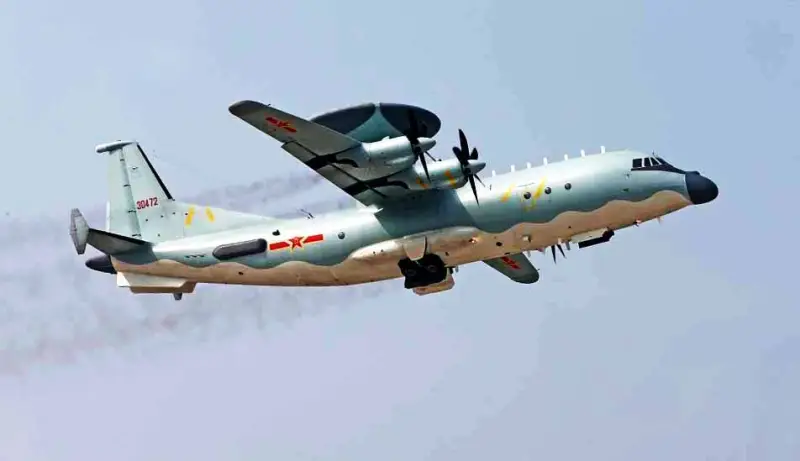
In the late 1990s, the PLA command came to the conclusion that it was necessary to have long-range radar patrol aircraft in the Air Force's combat strength. To this end, a Chinese-Russian-Israeli consortium was created in 1997, the goal of which was to create an aviation complex for early warning and control.
The contractors were the Israeli company Elta and the Russian TANTK named after. G. M. Berieva. The Russian side took upon itself the preparation for the conversion of the serial A-50 from the one transferred from the Russian Ministry of Defense, and the Israelis undertook to install the EL/M-205 Phalcoon radar on it. However, under pressure from the United States, the Israeli side in 2000 announced its withdrawal from the program with a high degree of readiness of the lead aircraft.
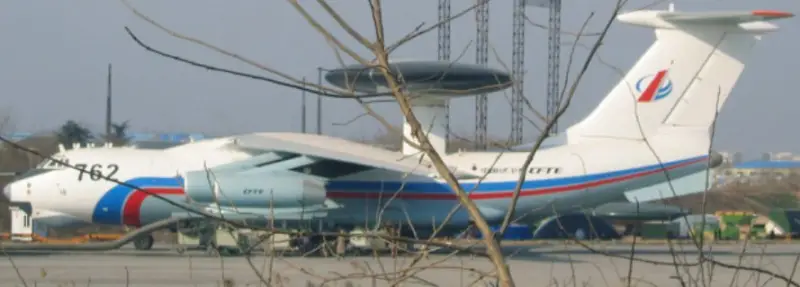
However, before this, specialists from the Middle Kingdom managed to gain access to materials relating to the Israeli radar complex, so Israel’s refusal to cooperate with China did not greatly affect the pace of creation of the Chinese flying radar picket, and already in 2004, trial operation of the first AWACS aircraft began KJ-2000. In total, the PLA Air Force received four such aircraft; the last aircraft of this type was delivered to the customer in 2008.
The KJ-2000 AWACS aircraft were built on the basis of the Russian military transport Il-76TD and were equipped with a Chinese radio-technical complex, which largely repeated Israeli developments.
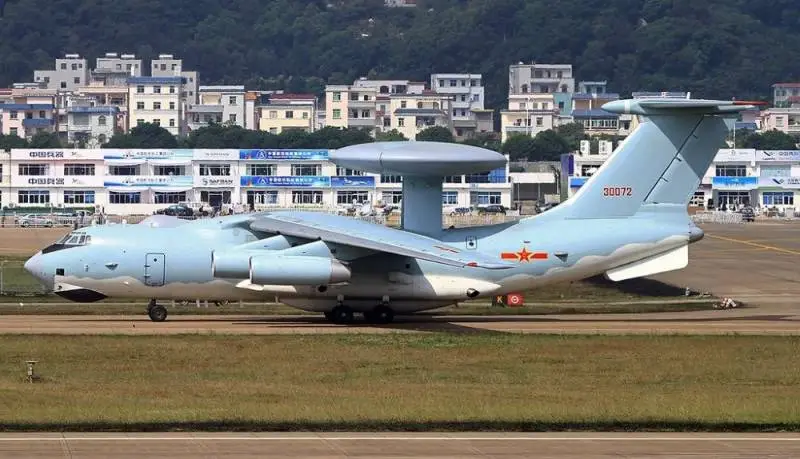
By the standards of twenty years ago, the equipment installed on board the KJ-2000 had quite good capabilities. A radar with an AFAR in a fixed mushroom-shaped fairing provided detection of high-altitude objects at a distance of more than 400 km and could simultaneously track 100 targets. In terms of detection range and the number of simultaneously tracked targets, the radar complex of the Chinese “Eye of Heaven” approximately corresponded to the characteristics of the RTK of the A-50 aircraft.
For its time, communications and navigation equipment was quite advanced, and radar information was displayed on color LCD monitors. Chinese media claim that one KJ-2000 is capable of simultaneously controlling the actions of several dozen combat aircraft.
Unlike the A-50, which Russia inherited from the USSR, the Chinese KJ-2000 did not stand idle at the airfield and actively participated in various exercises, in testing new missiles and combat aircraft, and also patrolled the airspace along the Formosa Strait and border areas with India. and Vietnam. In the intervals between exercises, tests and patrols, the AWACS aircraft underwent maintenance, repair and minor modernization at the Xi'an Aircraft Company (XAC) aircraft manufacturing facility in Xi'an.
Soon after the entry into service of four KJ-2000, Chinese representatives expressed interest in purchasing an additional batch of improved Il-76MD-90A with PS-90A3 engines for the construction of airborne radar posts, with improved avionics and electronic reconnaissance equipment. However, everything came down to the lack of new basic aircraft, which were not assembled in Russia in those years, and the customer refused to purchase used transport aircraft from the Russian Air Force.
The first Chinese production AWACS aircraft became milestone machines for the PLA Air Force, which allowed them to accumulate the necessary experience and develop application methods. Currently, the KJ-2000 has exhausted its service life and is being replaced by new Chinese AWACS aircraft.
Having analyzed the operation statistics of the KJ-2000, Chinese military analysts came to the conclusion that this heavy vehicle is suboptimal in terms of cost-effectiveness. The AWACS aircraft, created on the basis of a heavy jet transport aircraft, was too expensive, had low fuel efficiency and placed stringent requirements on home airfields. Experts decided that a middle-class aircraft with economical turboprop engines would be much more preferable for conducting regular patrols. Taking into account the cost of the base machine and the dimensions of the radio engineering complex, the search for the optimal option began. The military transport Y-8 (a copy of the An-12) and its improved version, the Y-9, were considered a suitable platform.
DRLO KJ-200 aircraft
Even before the commissioning of the first “strategic” AWACS aircraft based on the Il-76TD, work began in the PRC on the creation of a relatively inexpensive turboprop “tactical” flying radar post. The head prototype of the KJ-200 aircraft, built on the basis of the military transport Y-8F-200, took off on November 8, 2001.
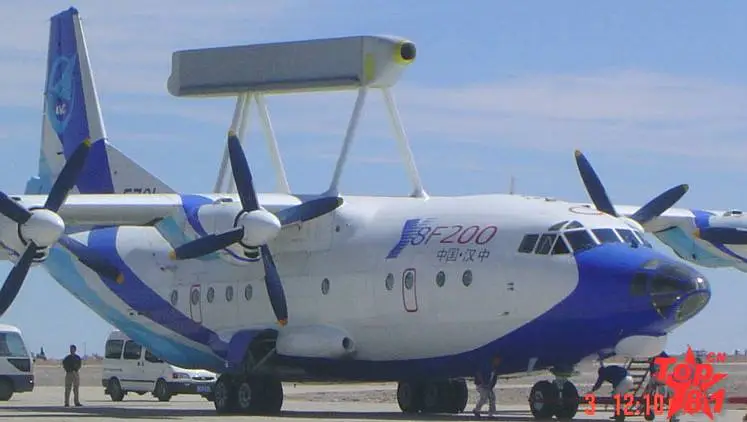
Like the “strategic” KJ-2000 AWACS aircraft, the KJ-200 “tactical” airborne radar picket uses a radar with a fixed AFAR. However, instead of a round dish-shaped radome, inside of which three fixed antenna modules with a field of view of 120° each are installed, the KJ-200 aircraft uses an antenna in an elongated radome.
Externally, the KJ-200 radar resembles the Swedish Ericsson PS-890 radar, but the Chinese station is much larger. The active transceiver modules are cooled by an incoming air flow, for which there is an air intake in the front part of the radio-transparent fairing. Since the radar viewing angle on each side is 150°, there are “dead” areas that cannot be viewed in the nose and tail of the aircraft. This forces them to patrol in pairs or constantly fly in an “oval” or “figure eight”. But during these maneuvers there is a possibility that target tracking will be lost. At the same time, foreign experts note that compared to the Saab 340 and Saab 2000 platforms with radars of a similar type, the Y-8 airframe provides large areas for the installation of electronic equipment, operator consoles and personnel rest areas.
In January 2005, the second prototype, built on the basis of the modernized military transport Y-8F-600, took off. This machine was actually pre-production, had new, more economical Pratt & Whitney Canada PW150B engines with 6-bladed propellers and a “glass” cockpit with avionics from Honeywell.
In June 2006, the second prototype crashed due to icing, which seriously delayed the KJ-200's adoption into service. After an investigation into the causes of the disaster, changes were made to the wing design and tail unit.
The KJ-200 “tactical” radar patrol aircraft officially entered service in 2009. A total of 9 production copies were built. Military tests of three KJ-200s began even before the official adoption of the aircraft.
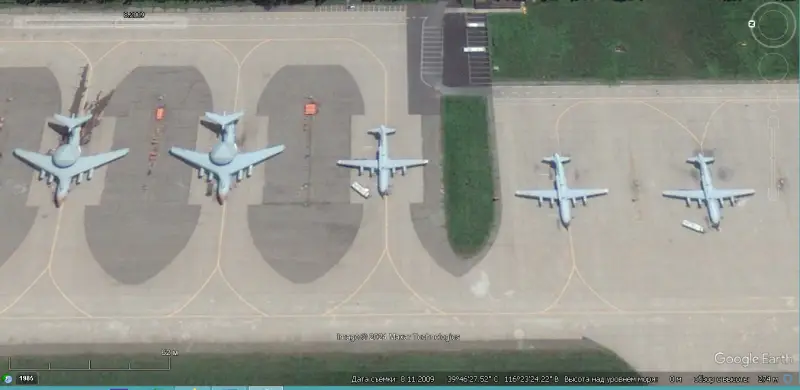
Google Earth satellite image: KJ-2000 and KJ-200 aircraft at an air base in the vicinity of Beijing, the image was taken in August 2009
During testing, turboprop AWACS aircraft were compared with heavy KJ-2000. The tests quite predictably showed that in terms of the capabilities of detecting air targets, processing and transmitting information, the KJ-200 airborne radio complex is noticeably inferior in terms of performance to the KJ-2000. At the same time, the turboprop KJ-200 was significantly easier to maintain and had much lower operating costs. An important factor was that preparation for the re-flight of the KJ-200 took 60% less time, and after fine-tuning, the reliability of less complex avionics, built mainly on the element base produced in the PRC, turned out to be higher.
The Chinese media published the following data for the KJ-200: maximum take-off weight is 61 kg, maximum speed is 000 km/h, ceiling is 660 meters, crew is 10 people. With a fuel reserve of 400 tons, the aircraft can stay in the air for 10 hours more than the KJ-25.
The radar is capable of detecting high-altitude targets at a distance of 350-400 km. The detection range of a target against the background of the ground is significantly less. Information about the air situation is transmitted to consumers via radio channel. Operators on board the KJ-200 can simultaneously control the actions of 12-15 interceptors. At the first stage, there was no opportunity to drop radar information in real time to the command posts of ground-based air defense forces and guidance points for fighter-interceptors.
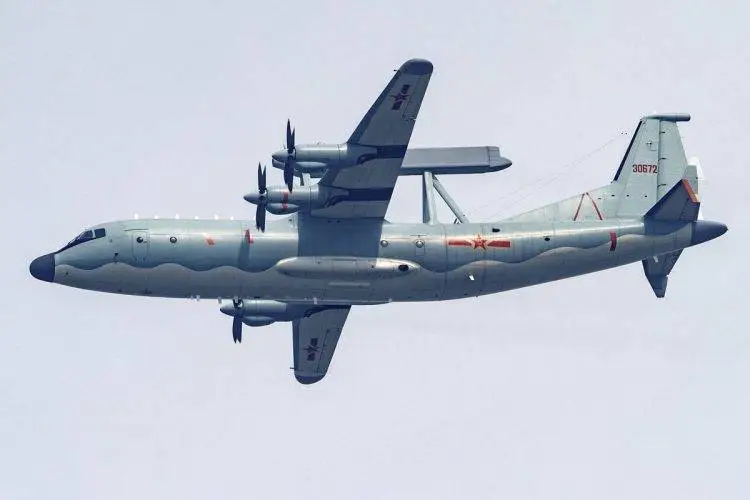
Chinese maritime aviation experienced an urgent need for a long-range radar detection aircraft, which was also capable of tracking surface targets. As a result, the production KJ-200s were divided with the PLA Air Force in a ratio of 2 to 1, and the admirals received three AWACS aircraft. However, later, after the appearance of more advanced KJ-500 aircraft, another KJ-200 was transferred to naval aviation.
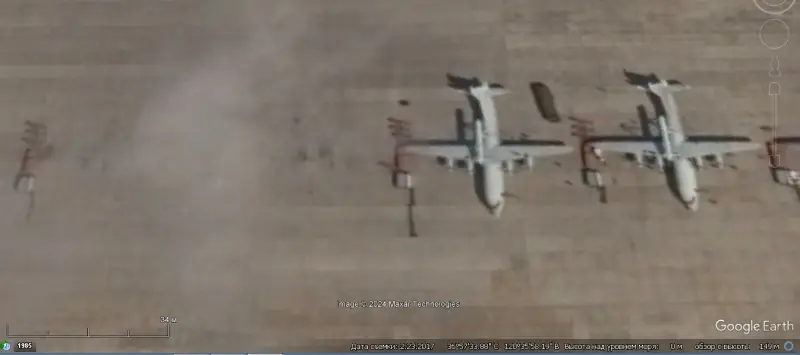
Google Earth satellite image: KJ-200 aircraft at Laiyang Air Base
Fleet KJ-200 radar patrol aircraft are assigned to Laiyang air bases in Shandong, Yalayshi and Lingshui on Hainan Island, which also host new KJ-500 AWACS, reconnaissance, patrol and anti-submarine aircraft: Y-8G, Y-8X, Y-8J and Y-8Q. All these vehicles are used to patrol the sea area adjacent to the Chinese coast, conduct reconnaissance at a great distance from the Chinese mainland, and fly over the disputed islands in the South China Sea.
DRLO KJ-500 aircraft
In general, the experience of creating the KJ-200 medium-sized AWACS aircraft turned out to be successful, but the Chinese military was not satisfied with the presence of dead zones due to the design of the radar. The experience gained by the developers and flight technical personnel of the combat units made it possible to form an understanding of what a modern “tactical level” radar patrol and control aircraft should be like, and to begin creating more advanced machines of this class.
According to the views of the PLA command, an AWACS aircraft operating for a long time at a considerable distance from its base must have an all-round radar, an in-flight refueling system and a wide range of electronic reconnaissance, data transmission and jamming equipment.
In accordance with these requirements, the KJ-9 was designed on the basis of the military transport Y-8 (an extended version of the Y-500 with new engines and avionics), the tests of which became known in early 2014. In 2018, it was announced that the KJ-500 aircraft had reached “full combat readiness.”
Unlike the KJ-200 with a “log-shaped” radar radome, the new aircraft has a round fixed radar antenna on the dorsal pylon.
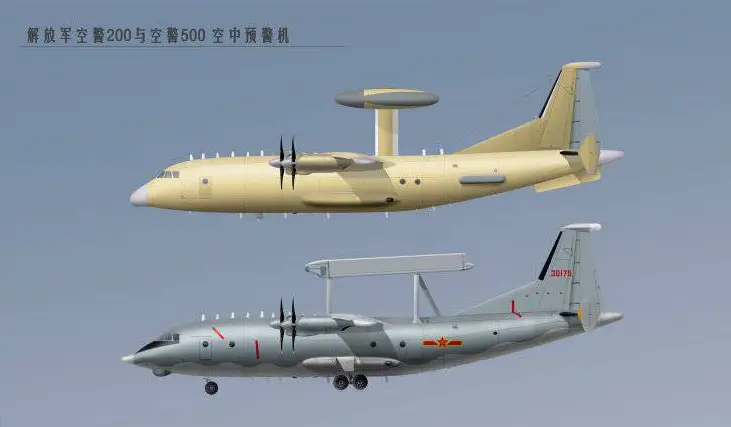
Also, external features of the KJ-500 are the presence of an aerodynamic ridge in the tail section to compensate for the loss of directional stability and flat antennas of a radio reconnaissance station. On the fixed radar radome of the Chinese AWACS aircraft, the viewing sectors of the AFAR emitters are indicated on top and there is a characteristic “blister” of the satellite communication antenna.
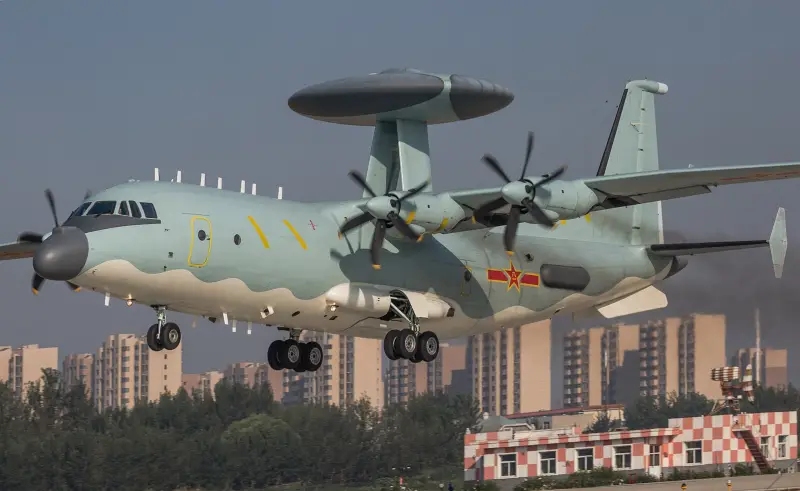
The great success of CETC Corporation specialists is the transition from radars with mechanically scanned antennas to systems with an active phased array antenna. The People's Republic of China managed to create and put into mass production a three-dimensional early warning radar with an AFAR, which provides electronic scanning in altitude and azimuth. In this case, the viewing sector of each of the three flat antenna arrays, docked in the shape of an isosceles triangle, is at least 140°. Thus, they mutually overlap adjacent sectors and provide all-round visibility. The presence of an electronic reconnaissance station with flat antennas in the rear part of the fuselage significantly expands the aircraft’s field of application.
The characteristics of the KJ-500 were not disclosed. Experts believe that the take-off weight is within 62 tons. Maximum flight speed is up to 660 km/h, cruising speed is 550 km/h, service ceiling is 10 m, maximum flight duration is approximately 400 hours, maximum ferry range is 10 km. The KJ-5600 radar is close in its capabilities to the radar of the American carrier-based Grumman E-500D Hawkeye AWACS aircraft, and the MiG-2 fighter flying at an altitude of 21 m can be detected at a distance of more than 8000 km, but the capabilities of the electronic reconnaissance complex of the Chinese aircraft are higher .
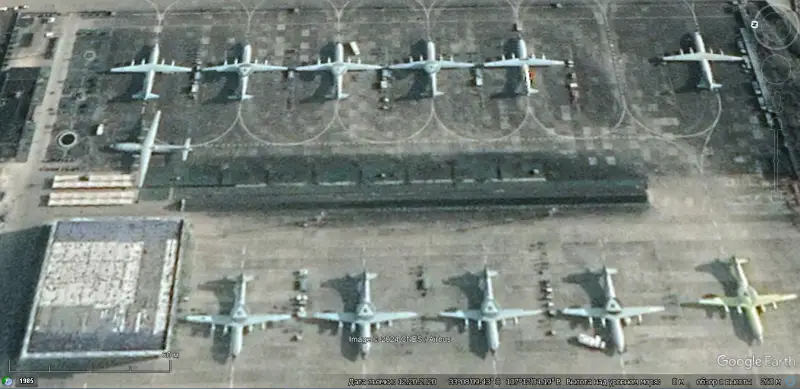
Google Earth satellite image: parking of finished products at the factory airfield in Hanzhong
Serial construction of basic aircraft for the KJ-500 is carried out at the Shaanxi Aircraft Corporation (a subsidiary of the state-owned holding company AVIC) in the city of Hanzhong, Shenxi Province.
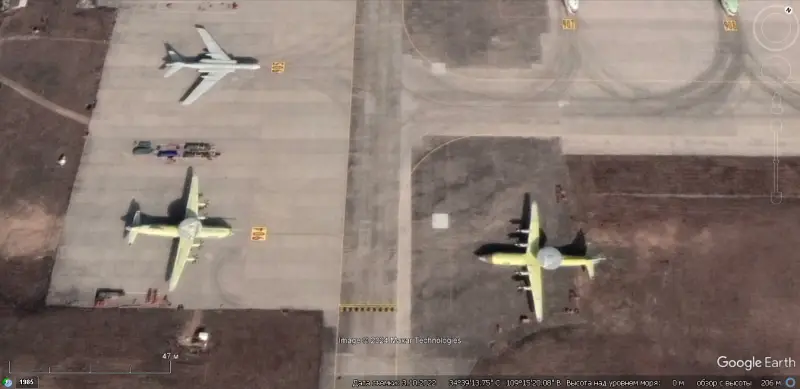
Google Earth satellite image: KJ-500 and N-6 aircraft at the factory airfield in Xi’an
Aircraft built in Hanzhong are transported to an aircraft factory in Xi'an, where the equipment is installed and put into operation. After which the new machines are handed over to the customer.
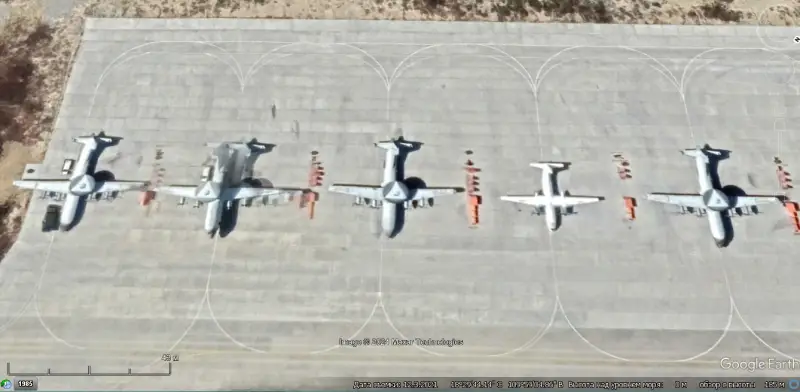
Google Earth satellite image: KJ-500 aircraft at Lingshui Air Base
As of 2023, Chinese industry has produced at least 35 KJ-500 aircraft. The PLA naval aviation has 14 vehicles of this type, which are based at the same airfields as its predecessors, the KJ-200.
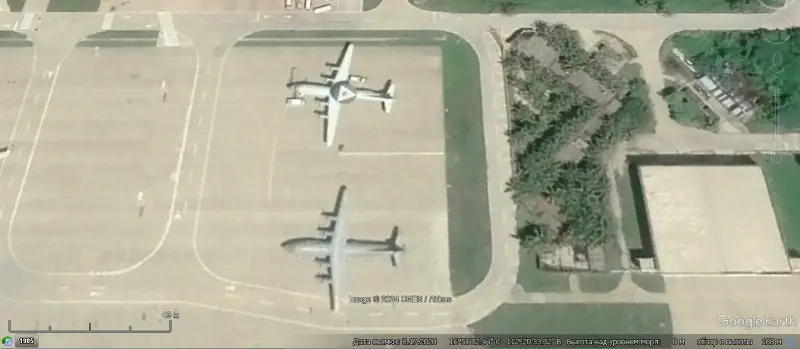
Google Earth satellite image: KJ-500 aircraft on Woody Island
KJ-500s also carry out long patrol flights away from their coasts. Aircraft of this type have been repeatedly spotted at the air base located on Woody Island in the South China Sea.
Y-8G long-range radar reconnaissance aircraft
Unique to Chinese naval aviation is the Y-8G aircraft, which entered service in 2005. A total of four such machines were built, one of them is part of the naval aviation. According to US data, the Navy's Y-8G is permanently based at the PLA Laiyang Naval Air Base in Shandong Province.
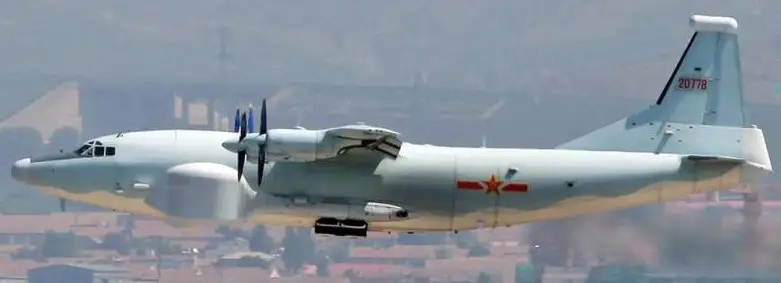
The Y-8G is based on the modernized Y-8F-400 transport aircraft, and is easily distinguished from other aircraft based on Chinese versions of the An-12 by the bulging antennas protruding from the sides between the cockpit and the wings. In order to mount them, the front part of the fuselage had to be redone.
The antennas protruding from the sides are designed for long-range radar reconnaissance of water and land surfaces over a long distance. The Y-8G is also equipped with powerful electronic warfare stations with antennas located on the top of the fin and in the tail of the aircraft.
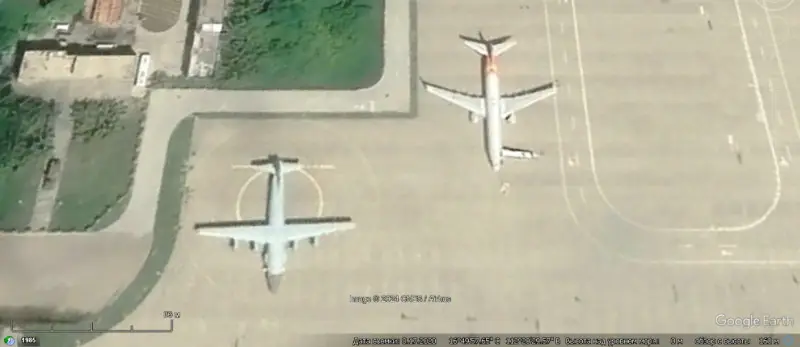
Google Earth satellite image: Y-8G aircraft on Woody Island
Just like J-11 fighters, H-6 bombers, Y-9Q anti-submarine aircraft, KJ-500 AWACS, the Y-8G radar reconnaissance aircraft regularly makes intermediate landings on Woody Island.
Carrier-based AWACS aircraft KJ-600
Initially, it was planned to include the Ka-31 and Z-18J radar patrol helicopters in the air wing of the first Chinese aircraft carrier Liaoning. However, having tested AWACS helicopters in action, Chinese naval commanders decided that, due to their insufficient range, low flight altitude and weak radio engineering complex, they were not capable of fully providing long-range patrols, timely warning and control of the actions of carrier-based fighters.
Practical work on the creation of a carrier-based AWACS aircraft in China began more than 15 years ago. In 2011, testing began on the experimental prototype JZY-01, built by the Xi'an Aircraft Company based on the Y-7 transport aircraft (a copy of the An-26). A total of two prototype aircraft were made.
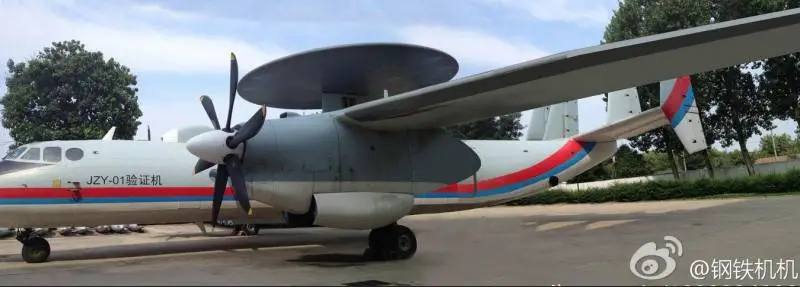
These aircraft were not intended for testing on an aircraft carrier. The vehicle was too large and did not have a folding wing, brake landing hook or reinforced landing gear. In addition, a very heavy aircraft could not take off from the deck of an aircraft carrier without the use of a catapult or solid rocket boosters. Apparently, the JZY-01 experimental aircraft were used to test the radio-technical complex and test layout and aerodynamic solutions.
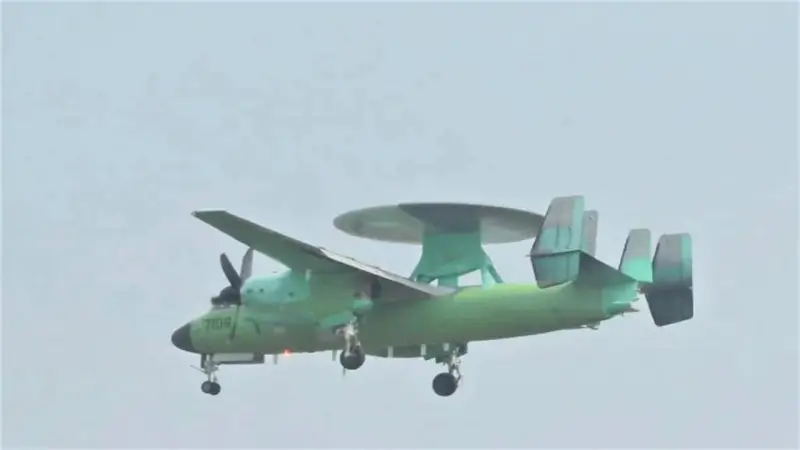
In 2017, it became known about the testing of the new carrier-based AWACS aircraft KJ-600, but not very clear photographs of the machine in the air appeared relatively recently. Judging by satellite imagery, at least four KJ-2023s were built by mid-600.
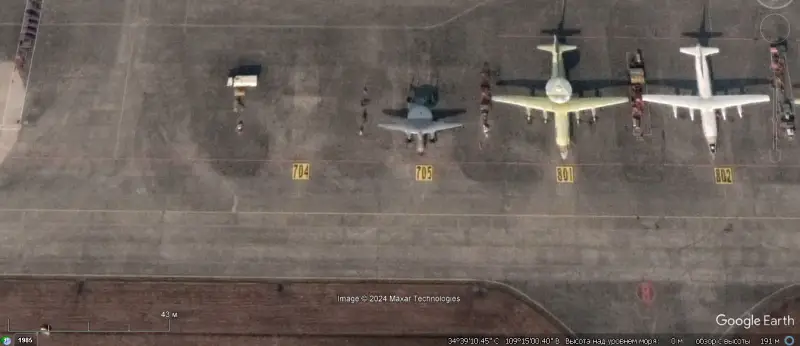
Google Earth satellite image: KJ-600, KJ-500 and Y-8 aircraft at the test parking lot of the factory airfield in Xi'an
The geometric dimensions of the Chinese carrier-based AWACS aircraft are close to the dimensions of the American E-2 Hawkeye, and the folding wing allows the KJ-600 to be compactly placed in the internal compartments of an aircraft carrier and the aircraft to be lifted using elevators. When designing the KJ-600, new composite materials were actively used, which made it possible to achieve high weight perfection and increase the service life of the airframe, which experiences increased loads when landing on the deck.
The network provides the following estimated characteristics of the KJ-600: aircraft length is about 18 m, wingspan is no more than 24 m (must fold at least 25% of the wing length), the height of the upper plane of the radar radome is 6 m, the diameter of the radar antenna radome is not more than 7 m. With such dimensions, the maximum take-off weight of the aircraft should not exceed 35 tons. The maximum fuel supply is up to 6 tons. Crew: 5-6 people. Maximum flight speed is up to 700 km/h. For patrolling at medium altitudes, the duration of stay in the air is 6-7 hours, and when flying at low and extremely low altitudes, the flight duration is no more than 5 hours.
Chinese sources claim that the basis of the radio engineering complex is the KLC-7 radar with AFAR, consisting of two sets. To increase noise immunity, the station simultaneously operates in two bands and performs both electronic and mechanical scanning of air and water space. It is possible to detect and simultaneously track more than 100 air targets, including such as anti-ship cruise missiles. At a flight altitude of 11 m, the KLC-000 airborne radar is capable of seeing large air objects at a range of up to 7 km. When decreasing to 550 m, the maximum detection range will decrease to 6000 km.
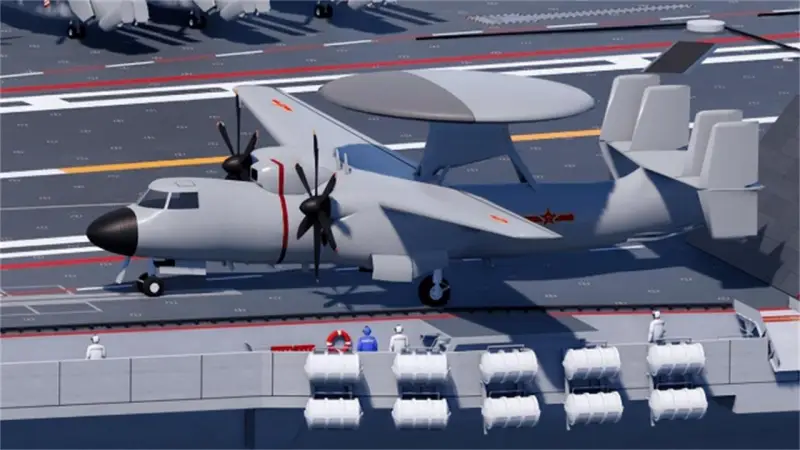
The KJ-600 airframes are assembled at the Shaanxi Aircraft Corporation in Hanzhong. Equipping with electronic equipment and factory testing of carrier-based AWACS aircraft are carried out at the Xi'an Aircraft Company in Xi'an.
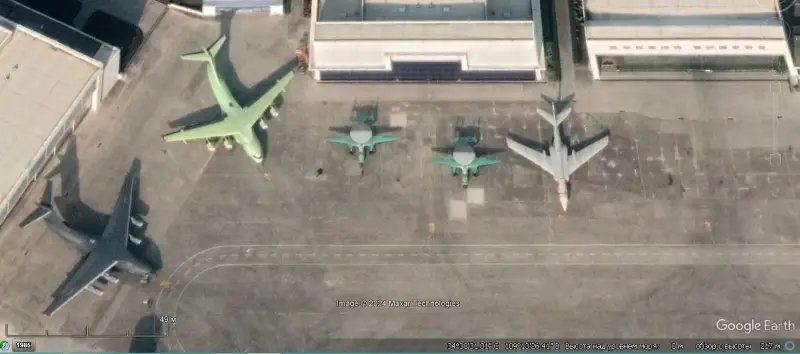
Satellite image of Google Earth: carrier-based AWACS KJ-600 aircraft, H-6 bomber and military transport Y-20 at the finished products parking lot of the factory airfield in Xi'an
Taking into account the fact that Chinese naval commanders plan to have four aircraft carriers, 10-12 radar patrol vehicles will be required to staff their air wings. Another 2-3 aircraft will be needed to train flight and technical personnel, as well as to create an operational reserve. The Chinese aviation industry can deliver such a number of KJ-600 aircraft in 2-3 years.
In terms of the number of capable long-range radar patrol aircraft in service, China is already several times greater than Russia. At the same time, the PRC places emphasis on the construction of relatively cost-effective “medium” airborne radar posts. Aircraft designed for the “tactical” level are, if necessary, capable of performing “strategic” missions. While losing to the Russian A-50U in terms of flight speed, number of tracked targets and guided fighters, turboprops with almost the same flight range can “hang” in the air longer. The lower performance of the RTK is fully compensated by the large number of “tactical” AWACS aircraft available in China. Separately, it is worth noting the creation and launch into production of a carrier-based AWACS aircraft, which will certainly expand the combat potential of the PLA Navy aviation.
Продолжение следует ...
Information